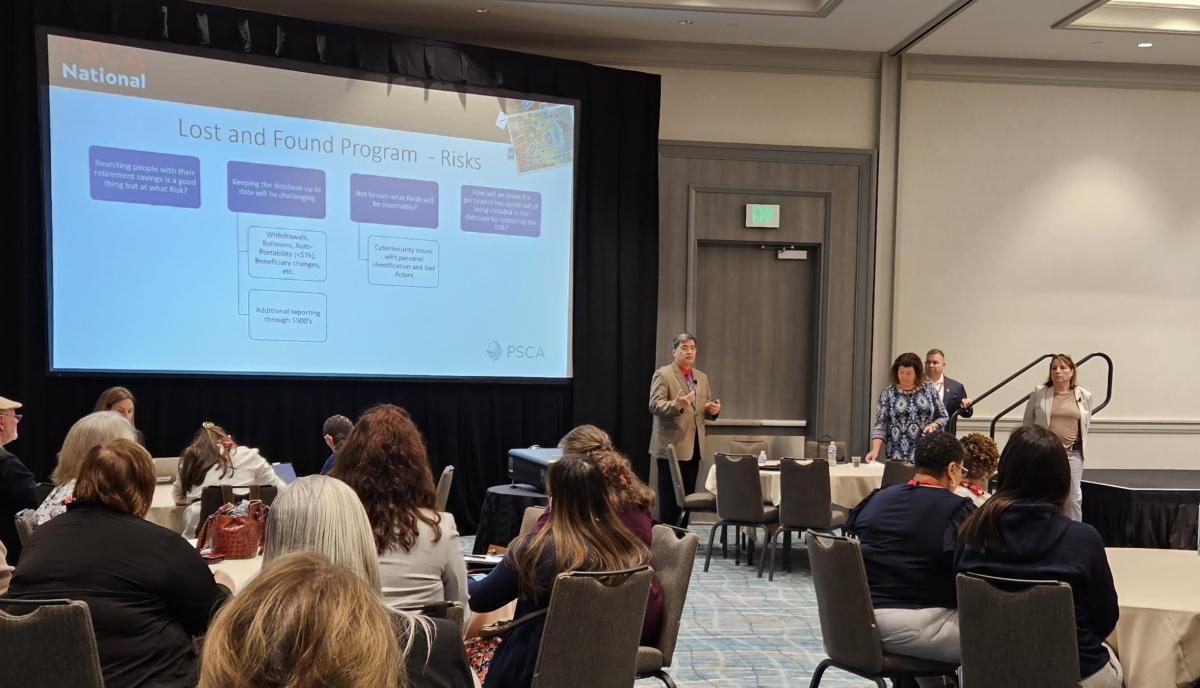Advertisement
Be a BOSS, don’t let your participants get lost!: PSCA National
One of the breakout workshops at PSCA national focused on the much talked-about challenge of tracking down missing participants. Judging by the hundreds of session attendees, it is a topic top-of-mind for plan administrators. The workshop was presented by plan sponsors Sharon Heymans with Occidental Petroleum Corporation, Rick Kucirek with Christ the Kind Church, Rose Murtaugh with Navistar, Inc., and moderated by Peter Lohri from Enterprise Iron Financial.
The presenters started with a discussion of the new SECURE 2.0 provision that is aiming to help address the issue of missing participants by creating a Lost and Found database to help participants track down their old retirement accounts. This provision, that goes into effect Jan 1, 2025, though aiming to help reunite participants with their money, drew skepticism from the panel about its ability to do so. The panel stated that plan sponsors are awaiting guidance from the DOL to clarify how this will work including reporting requirements and other administrative details.
 How do you know if a participant is missing? If you start receiving returned mail, have a lot of uncashed checks, and/or a participant has reached normal retirement age (or RMD age) and has not started taking a distribution, they may be “lost.” Advice to get started finding your missing participants includes going after the “low hanging fruit” before becoming a “super sleuth” according to Sharon Heymans. Guidance from the DOL’s missing participants best practices include scrubbing census data, management of beneficiaries, and death sweeps. After that Heymans says she becomes a detective and will do whatever it takes to track someone down including searching social media (and sending personal messages that no one has ever responded to), searching obituaries (tribute.com was mentioned as a good resource), contacting the SSA to determine if someone is deceased, and using any resources available to try and track down relatives. Pro-tip: search for the kid with the most unusual name, not the kid with the common name. A quick audience poll showed that 70 percent of attendees have not used social media to track down participants or relatives. Another poll showed that most do not have a formal returned mail policy either.
How do you know if a participant is missing? If you start receiving returned mail, have a lot of uncashed checks, and/or a participant has reached normal retirement age (or RMD age) and has not started taking a distribution, they may be “lost.” Advice to get started finding your missing participants includes going after the “low hanging fruit” before becoming a “super sleuth” according to Sharon Heymans. Guidance from the DOL’s missing participants best practices include scrubbing census data, management of beneficiaries, and death sweeps. After that Heymans says she becomes a detective and will do whatever it takes to track someone down including searching social media (and sending personal messages that no one has ever responded to), searching obituaries (tribute.com was mentioned as a good resource), contacting the SSA to determine if someone is deceased, and using any resources available to try and track down relatives. Pro-tip: search for the kid with the most unusual name, not the kid with the common name. A quick audience poll showed that 70 percent of attendees have not used social media to track down participants or relatives. Another poll showed that most do not have a formal returned mail policy either.
Rose Murtaugh stated that they do not have the staff and resources that Heymans does and that the amount of detective work you do on your own is really up to your own comfort level. She prefers to have guidance and specific rules to follow. She stated she once found an address of a long missing participant that turned out to live very nearby her and though she briefly considered knocking on the door, she didn’t as that was outside her comfort zone, to which Heymans stated she probably would have.
Though Murtaugh and Heymans have very different approaches to tracking down missing participants, neither is wrong – the key is to have a documented, written policy and to follow it. According to an audience poll, more than half of attendees do not have a written policy. Murtaugh stated that they have a structed written policy and they engaged a commercial locator service which quickly located half of their several hundred missing participants with a quarter of them self-verifying without further follow-up. The panelists stated that these third-party services are actually pretty cost effective. An audience poll showed that 60 percent of attendees do not use a commercial locator service. Because of Murtaugh’s written policy, adherence to it, and use of a service to track down participants, she survived a DOL audit without a problem (even though she wasn’t knocking on doors).
An attendee asked what happens if you locate a participant after RMD age – if you have to payout plus interest. The panelists stated you do and it is an administration nightmare so the best advice is to do everything in your power to locate participants before they reach RMD age.
The key takeaways?
- Make sure your beneficiary forms are complete and have a process to update them regularly.
- Have a process in place for dealing with returned mail and verify addresses annually.
- In addition to verifying addresses, collect personal contact information including social security numbers, personal email addresses, and hone/cell phone numbers.H
- Use social media to see if you can track them down.
- Use available online resources such as obituaries.
- Consider using a commercial locator service.
- Above all else, have a formal written policy and follow it.
Happy searching!
